

Discover the Tuscan Archipelago by boat with its seven pearls, the Islands of Elba, Giglio, Giannutri, Capraia, Pianosa, Montecristo and Gorgona. The most suitable to explore by boat are Capraia, Giglio and Elba. In this article, we're going to suggest an itinerary along Elba and Capraia Island in a sailing experience that will awaken all your senses, in the words of someone who has been there! Namely, we're going on a journey with skipper Giovanni Pomari. With several sails on his shoulders, Giovanni has helped us shape this itinerary. You'll find some precious advice on how to visit the Tuscan Archipelago without missing the fascinating stops.
"Hi, I'm Giovanni. I love the sea, nature and the tranquillity you get when you're in it. I've been sailing since I was 10, a passion that has been growing since. I have recently obtained the Rya Yachtmaster offshore, both for sailboats and motor boats, with a qualification for commercial use up to 200 tons. Sailing and the sea are a great school of life and every day I'm amazed at just how beautiful and fantastic sailing is."
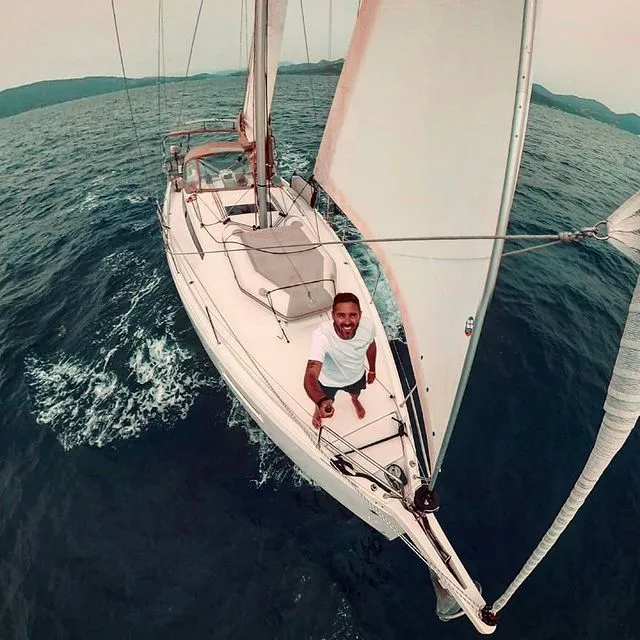
Skipper Giovanni right by Elba Island (source: Giovanni Pomari)
The ports from which you can set sail for the Tuscan Archipelago are mainly (from the north): Marina Cala de Medici, Marina di San Vincenzo, Marina di Scarlino and Punta Ala, all located between the cities of Livorno and Grosseto.

The main ports on the island of Elba are Portoferraio (Darsena Medicea), Marciana Marina and Porto Azzurro. Here you will find safe moorings both in summer and winter.
Sailing counterclockwise from Portoferraio, you will find the Ghiaie beach (Spiaggia delle Ghiaie), turquoise water and a beach of small white stones.
You can get there easily with a calm sea, and it is definitely worth a stop for a swim. I do not recommend spending the night here because it can be a noisy spot due to the frequent passage of ships.
Continuing, we come to the Gulf of Procchio, a spacious inlet with, in my opinion, some of the most beautiful beaches on the island: the Biodola beach and the beach that gives its name to the Gulf, the Procchio beach.
Here you will find small inlets such as Viticcio and La Tonnara, which are very beautiful, but above all, very safe for spending the night at anchor. The compact sandy bottom allows the anchor to hold very well, even in strong winds. When the marinas are often full in the summer months, you can spend the night even in bad weather. Close to winds from the southeast and southwest.
Sailing westwards at the end of the Gulf is Marciana Marina. A well-equipped harbour with electricity and fresh water on the jetties (VHF ch 9). If you don't want to enter the port, you can drop anchor almost at the harbour's mouth and go ashore with the tender.
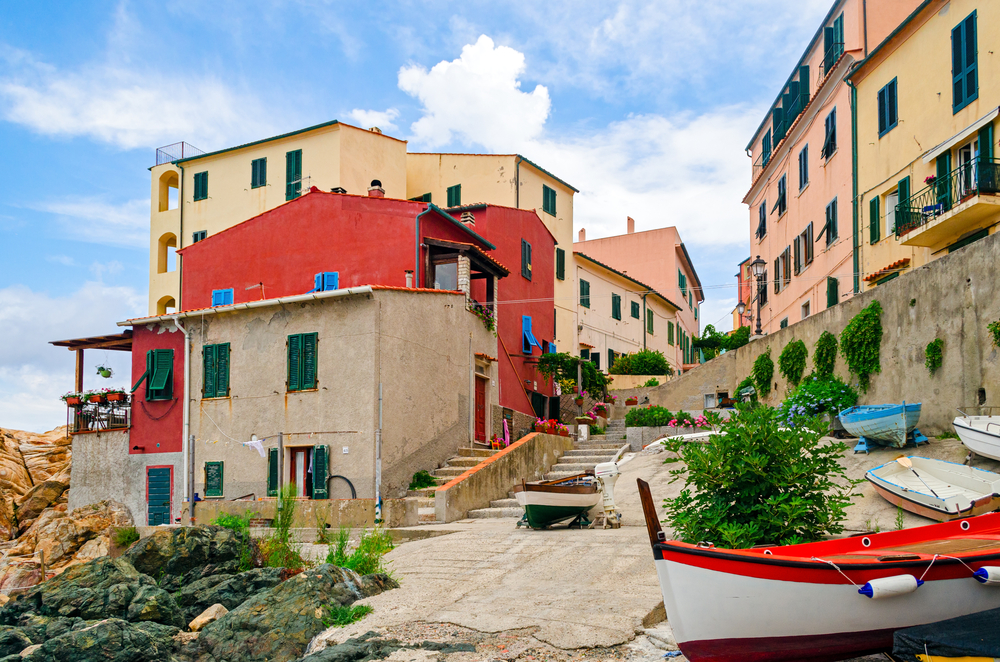
Marciana Marina village, Elba
Continuing westwards, a few miles from the harbour, I suggest you stop for a swim at "Alle Piscine". A bay of smooth rocks polished by the sea. Here the sea has smoothed the rock over time, creating natural pools. I recommend sailing here only in good weather with little wind, preferably in the morning. In the hot hours, the heat from the north-west rises, which can make a stop here uncomfortable.
We continue our tour on the extreme tip of the island, in the direction of Corsica, opposite Pomonte beach. About a mile from the coast you can stop near the Ogliera rock. Here lies a famous wreck, the wreck of the Elviscot (a cargo ship that sank in the 1970s) on the seabed: with the entire stern, the bridge and part of the side lying on the sandy bottom at a depth of just 10 metres.
We sail eastwards from the wreck for about fifteen miles of sheer coastline, coming across a small inlet: Fetovaia, a small beach of fine white sand where I recommend both swimming and a night's stay. Here, the roadstead is particularly safe with the winds coming from the northwest and west, open to the Scirocco and Libeccio.
Heading east, we come to the village of Marina di Campo and its gulf. Here you can stop for a swim and a visit to the village during the day. The marina is not very well equipped but has a quay with a petrol station, which allows you to moor once closed. Here you will find little seabed and poor holding ground1 throughout the Gulf.
Once past Marina di Campo, there is the Gulf of Lacona, with a seabed suitable for the night, and Golfo Stella, which I recommend visiting for a swim and a night-time stop.
A few miles away, you will find Punta Calamita, an old disused pyrite mine, discovered by the Etruscans and also known to navigators because in that stretch of sea the compass can give wrong readings due to magnetism produced by the strong presence of pyrite. It is very dark here, and the beach is very particular because of its black colour given by the ferrous residues.
We then enter the Gulf of Porto Azzurro. Whether you enter from the right or the left of the gulf, you will find many beaches and inlets for a swim. The seabed here is good. The inlet is quite deep, on our right as we enter we find the tourist port equipped with water and electricity at the quay and immediately attached to the port town. A small fishermen's village that has been completely renovated. In summer, the municipality of Porto Azzurro offers many cultural initiatives and events for tourists. The roadstead here is very safe with westerly and north-westerly winds. It can be more troublesome with winds from the east and south.
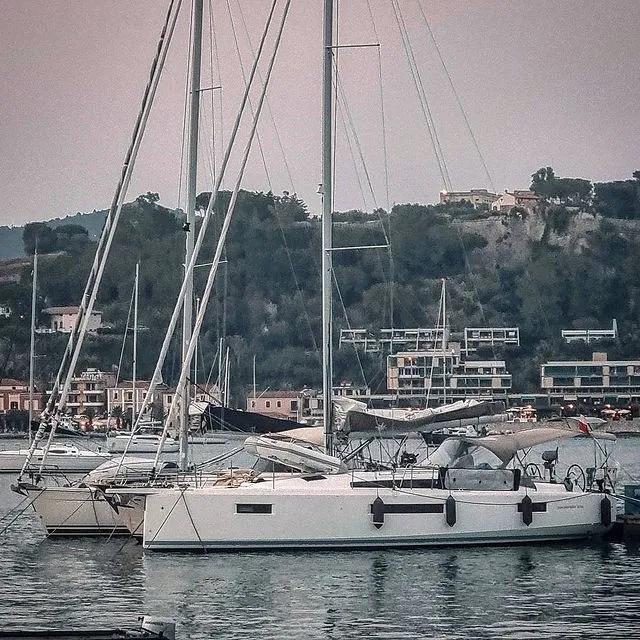
Porto Azzurro (source: Giovanni Pomari)
We continue sailing towards Marina di Ortano, a small, very pleasant inlet with a small beach for swimming, Rio Marina and Cavo, where the ferry and hydrofoil arrive. Rio Marina is a very pleasant stopover for a night, the centre of the town is walkable. In Cavo, there is a small marina on a floating pier for boats up to 13 metres long. In summer (when ferry and hydrofoil services are particularly frequent) you may find an undertow that could cause problems when navigating.
Between Cavo and Portoferraio, you will find many inlets, ideal for swimming, but not recommended for the night (they are too exposed to the undertow of the ships).
Napoleon Bonaparte said that the Gulf of Portoferraio is the safest harbour in the Mediterranean. You can dock on the opposite side of the bay from where the ferries dock, at Bagnaia. I advise you to pay attention to where the anchor falls because the seabed is a mixture of seaweed and sand. At the end of the Gulf, I do not recommend sinking because the seabed is muddy and the anchor can lose its grip in windy conditions.
The island is about twenty-five miles north-west of Marciana Marina.
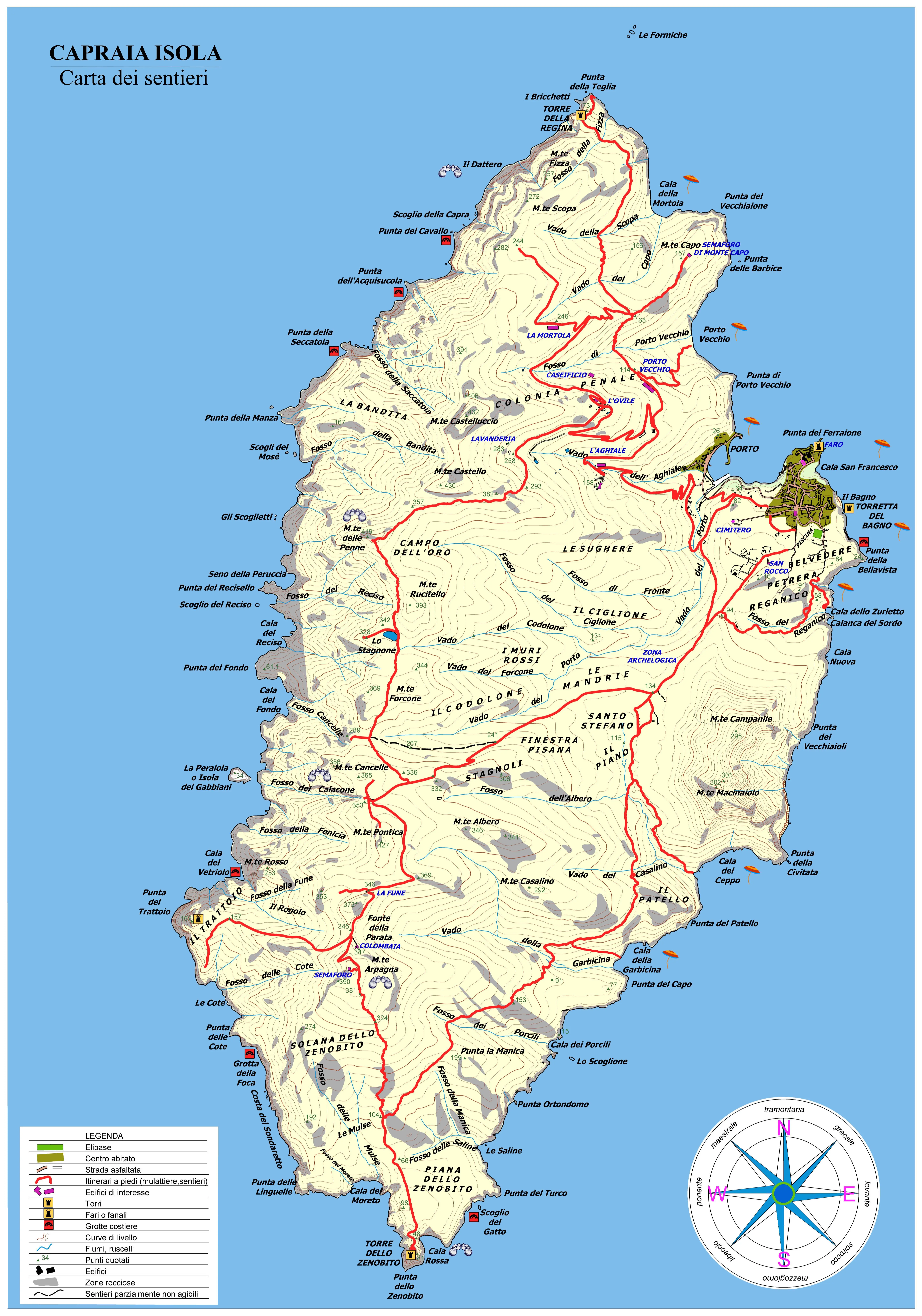
Capraia Map (Source: Proloco Capraia)
Arriving from Elba you will find the entrance to the port on the north-east side of the island. In summer it can be difficult to find a place and I advise you to book by phone beforehand if you intend to stay here.
The roadstead where you can go down is just before the entrance. When the weather is good you can go down even if there is always a bit of undertow, and be careful of the seabed because even near the coast there is a lot of depth. It is very dangerous to dive at night when the weather forecast is for north and northeast winds.
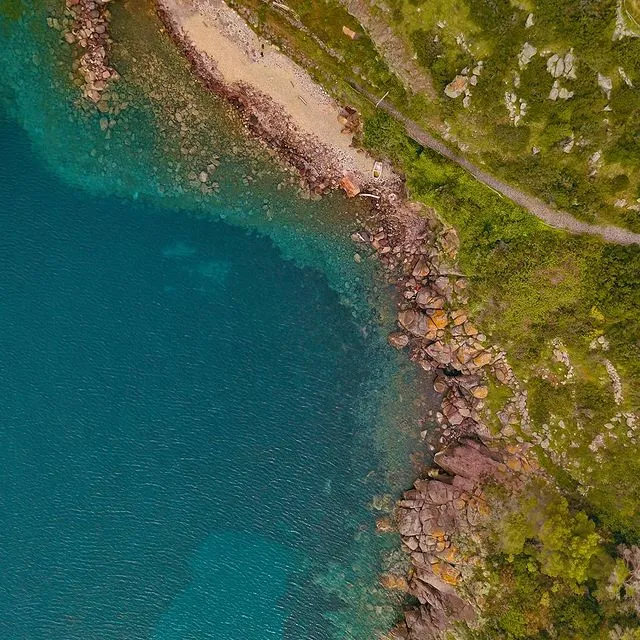
Drone shooting of Capraia (source: Giovanni Pomari)
It is a rocky island with no beaches except for a small pebble beach near the harbour. The village is located high up and can be reached from the harbour along a panoramic road. From here, on days without haze, you can admire the entire coast of Livorno. It definitely deserves in my opinion.
The most famous and suggestive inlet is Cala Rossa on the island. If you find yourself exploring it in the summer months, spectacular colour contrasts are created here at sunset: the cove turns deep red, creating an enchanting contrast with the cobalt blue of the sea. I would definitely recommend this cove for a swim.
Between the port and Cala Rossa, you will find Cala Del Ceppo, ideal for a swim. Looking out to sea and with the entrance to the port on the right, you will find the breeding of sea bream at the beginning of an inlet. Here you can drop anchor for a swim and spend the night. In my experience, if the weather is bad it is safer to moor here than in front of the harbour.
Follow Giovanni's sailing wanders on Instagram @sailing.pomo
1 Holding ground: Due to the nature of seabed, anchoring can have good or bad holding ground. Sand is considered to be the strongest holding ground. Soft mud is the least holding ground. This is because of obvious reasons. Anchor embedded into soft mud would leave the bottom easily compared to the harder surface like sand. Sailors must consider the nature of the seabed to determine the possibility of dragging the anchor.
2 Dropping the anchor: dropping the anchor into the sea so that it falls to the bottom of the sea, hooks up and stops the boat

Our regular email newsletters include information about our boats, holiday ideas, destination insights and cultural briefings. You can unsubscribe at any time and we'll treat your data with respect, never passing on your details to third parties. Find full details of our data management in our Privacy policy page
By signing up, I agree to Sailogy's T&C's and Privacy policy

Looking for inspiration for your next sailing holiday? Packed with insights on trending sailing destinations plus stories from expert sailors and first-timers, our brand new digital magazine - Magister Navis - will guide your way to your next sail.
View magazine